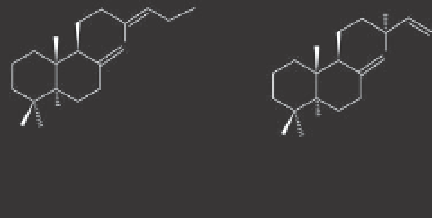Biology Reference
In-Depth Information
profile of an ethanolic propolis extract col-
lected from La Unión municipality, located in
the South-east region of Antioquia (Fig. 7.8).
From this analysis the following com-
pounds were detected: (i) methyl and ethyl
esters of saturated and unsaturated fatty
acids (peaks 10, 17, 18); (ii) various sesquit-
erpenes previously reported in European
propolis (cadinene, muurolene, cadinol and
muurolol) (Silici and Kutluca, 2005; Melliou
et al
., 2007); (iii) six pentacyclic triterpenes
(peaks 6, 9, 20, 24, 29) such as cicloartenol
acetate and 7-friedouren-3-ol, which showed
a characteristic fragmentation pattern with
peaks at m/z 177 (84%), 191, 341, 205
(Budzikiewicz
et al.
, 1963), and 3-lupanol
acetate which showed an ion at m/z 191;
(iv) two types of diterpenes (bicyclic type
labdane) and a tricyclic acid (abietic acid).
Similarly, a later study established the
chromatographic profile of some propolis
samples collected in Antioquia's Department
yielding the results shown in Table 7.3.
These results showed evident differ-
ences in the chemical composition of prop-
olis from the Antioquia Department and
reflect the complexity of the mixture. We
can appreciate that these samples are mainly
OH
OH
H
H
R
1
HO
36
R
1
= COOH
37
R
1
= CH
2
OH
38
Fig. 7.7.
Labdane type diterpenes isolated from
Antioquia Department propolis.
Abundance
100
20
28
27
75
29
19
24
30
25
32
50
14
26
33
18
25
17
7
8
10
6
0
Time:
14.77 15.78 16.79 17.82 18.83 19.86 20.87 21.90 22.91 23.93 24.96 25.96 26.98 28.00 29.02 30.04
Fig. 7.8.
An enlarged version of a gas chromatographic profile of a propolis sample collected in La Unión
municipality.


Search WWH ::

Custom Search